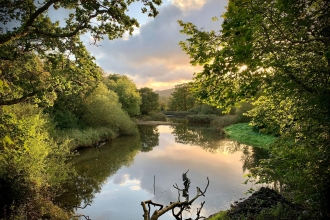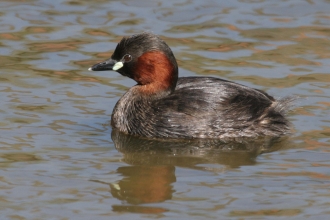In Part 1 and Part 2 of our series, we visited the Main Hide and the birds you may see and hear during your visit to the Spinnies Aberogwen Nature Reserve. Exiting out the main gate and back onto the road, if you continue to walk along up towards the carpark you will stumble across the next two hides: The Kingfisher Hide and the Viley Hide. This part will be about our popular Kingfisher Hide.
Songs of the Spinnies - Part 3: The Kingfisher Hide
A kingfisher on a tree branch @Jon Hawkins
The Kingfisher Hide
The Kingfisher Hide (Cuddfan Glas Y Dorlan) is the first hide you will come across as you walk up towards the carpark, with the gate and path to your left leading you through a small woodland area to said hide. This hide is higher up above the ground, so it is accessible by a small wooden staircase. This hide overlooks the same lagoon as the main hide, so you can often spot similar birds you can see at that hide, such as the little egret, grey heron, and spotted woodpecker, and many of the other different waders. The feeders also attracts the small songbirds, like the finches.
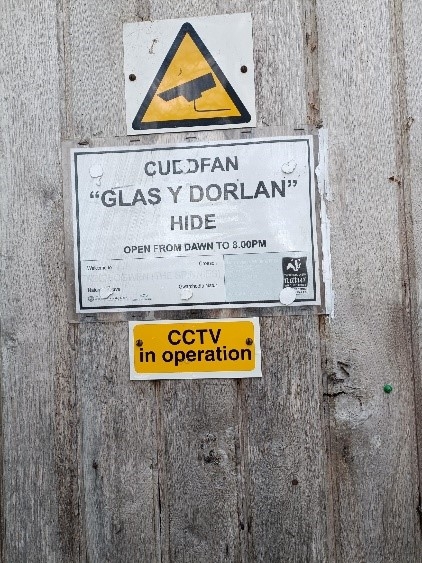
The Kingfisher Hide's Door/Drws Cuddfan Glas y Dorlan @ NWWT Michelle Payne
Obviously, the hide gets its name from the fact that you can see the kingfisher here, often as a blue flash as it darts across the water. One of the perches at this hide is designed to attract the kingfisher here so you can take a closer look and perhaps take some great photos. The kingfisher makes a sharp loud “kit-cheese” and a “cheee” whistle sound.

Kingfisher/Glas y Dorlan @ Amy Lewis
You can also see the moorhen and the little grebe at this hide. Moorhens make loud throaty or metallic notes like a “kurruk”, a “kittik”, a “kik” or a stuttering “kik-kikikikikik-ik”. The little grebe has a distinctive high-pitched whinnying “bibibibibibibi” trill during it breeding season, typically during summer.
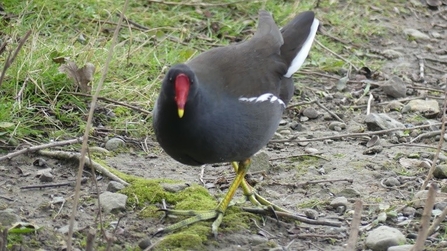
Moorhen/Iâr ddŵr @ NWWT Daniel Vickers
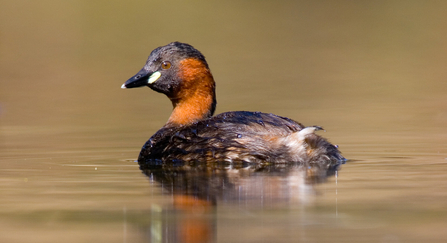
Little grebe/Gwyach fach @ Tom Marshall
Many of the songbirds we’ve mentioned over at the Main Hide can also be seen at this hide, as well as some of birds we will mentioned at the Viley Hide. Along with these birds, you might also spot the long-tailed tit at the Kingfisher Hide. The long-tailed tit song is rarely heard, a soft twittering. Normally it will be their calls that you will hear, loud and sharp “srih-srih-srih” and sometimes a more explosive and rippling “zerrr”, along with calls that are more like a “pt” or “zepp” clicking sounds.

Long-tailed tit/Titw cynffon hir @ Neil Aldridge
Often mallards can see from this hide as well, either out on the water, or nesting on the little islands of land. The males often make quiet whistles, while the females make the loud “quark, quark, quark” sound, that most people associate with mallards.

Photo of a male and female mallard/Llun o wryw a benyw hwyaden wyllt @ NWWT Daniel Vickers
Mallards are very common and can be found all across the UK, but if you need to take some time out from trying to spot the quick flash of blue of the kingfisher or the rustle of movement in the reeds, as the moorhen hides from view, there is something quite nostalgic and peaceful about watching the ducks floating along the water.
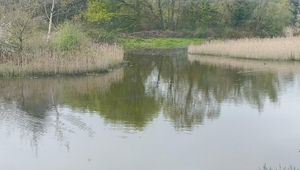
View of the lagoon from the Kingfisher Hide/Golygfa o’r môr-lyn o Guddfan Glas y Dorlan @ NWWT Michelle Payne
In our next and final part of our series, we will be discussing the Viley Hide.
PREVIOUS: Song of the Spinnies Part 2 NEXT: Song of the Spinnies Part 4


